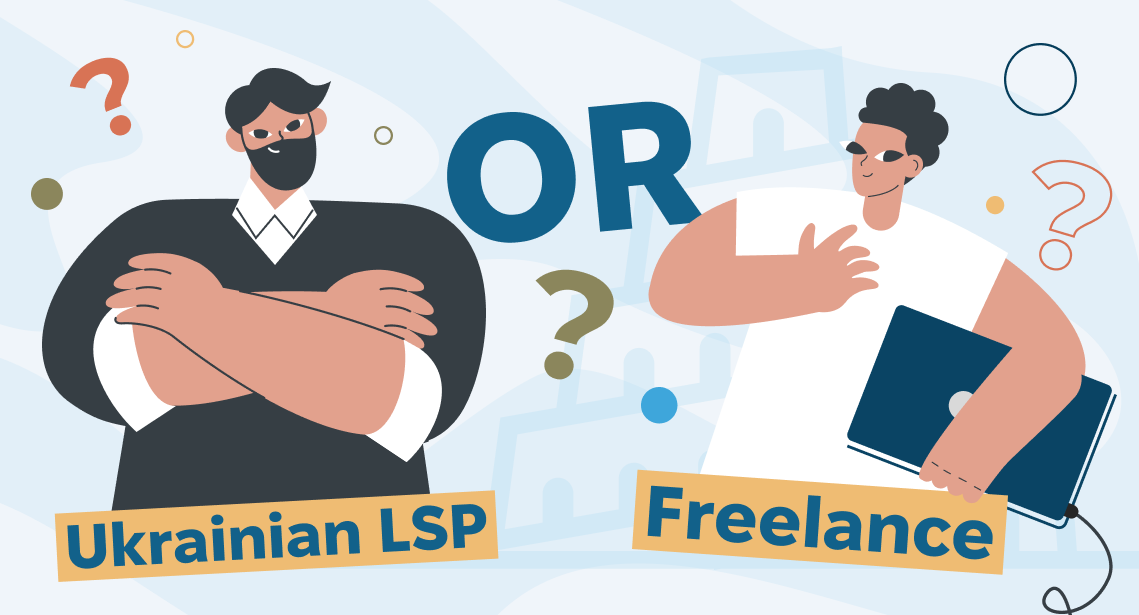Behind the scenes of a translation agency’s operations

In this article, we will tell you what happens at a translation agency after your order has been received. It would seem that there’s not much to tell: the text is received, sent to a translator, received from the translator, and sent back to the client. Not only is the process more complex than that, but many translation jobs involve micro-dramas that, for your peace of mind, nobody will tell you about.
Let’s look behind the scenes and see what takes place.
What happens to your files when they are out of your sight
Sometimes a client will send a file and ask to have it translated while paying no heed to such a “little” thing as document format. But for the translation agency, how easily the text can be processed in various software applications is critically important. For instance, if the client sends a scanned copy of a document, the translation agency will have to OCR and then correct the text before it can be translated.
Clients often send translation agencies PDF files and expect the translated file to look the same as the original. However, the PDF format is extremely inconvenient for translation. It was developed by Adobe to eliminate the dependence of the displayed text and images on the platform, and it achieves that end. However, it is not so easy to convert PDF files to an editable format. Then, once the translation is complete, it is still more difficult to convert the translation back to PDF while retaining the format and layout of the original. The layout process is a separate and rather time-consuming operation that requires an additional person, the layout designer. Even if the translator himself can perform the layout and conversion, he will have to spend additional time.
These additional services — OCR, editing, layout, etc. — thus naturally add to the cost of a translation job. The client usually knows nothing of these operations in the background and assumes that the translation agency has merely provided a “simple translation.” Often, translation agencies prefer not to overload the client with unnecessary details, and thus include all of the various stages in the translation price and collectively call them “translation.”
Therefore, to make a translation job less expensive, if possible send the files in an editable format: either text (for example, Microsoft Word format), or the original format from which PDF files were created (PDF is always a secondary format that was created from a different format). Otherwise, the translation agency will either have to decline the project because it is unprofitable and time-consuming or raise its fee to accommodate the additional work.
Even for files that are in a straightforward editable format, any serious translation agency will perform a series of steps to translate it:
- Analyze the text using special software applications that search for repetitions. Many repetitions mean less work, so the translation agency may offer you a discount.
- Convert the files into special formats.
- Translate and edit the converted text.
- Use additional software tools to detect and correct various errors.
- Convert the file containing the translated and edited text back into the format originally sent by the client.
- Perform a final check on the file to ensure that it is converted correctly.
- Send it to the client, who in most cases does not have the slightest idea how complex the process is or is just reluctant to get into the technical details.
The above steps are required to ensure quality. Many translation agencies have internal proprietary know-how for these various steps, often designed for a specific language or program. The steps are not difficult if the file is in an editable text format. If the client sends a scanned image or PDF file with a complicated layout, these operations get dramatically more difficult and the translation agency has to use “antiquated methods”: OCR the text or type it manually to translate it in the usual way afterward (or just sight-translate it without any professional tools). This increases the project cost for the client and reduces its attractiveness for the translation agency. Thus, both parties win if the files are easy to process.
Urgent call to arms: how it happens
Translation is a very time-consuming job. Translators work at different paces. The norm is considered to be one page (250 words) per hour or eight pages (2000 words) per day. Even a translator working overtime and as fast as possible is not likely to be able to translate more than 20 pages (5000 words) per day without sacrificing quality. Furthermore, such a pace is not sustainable.
Translation agencies are often contacted by clients who need their text to be translated “yesterday.” For instance, a client requests that 1000 pages (250,000 words) be translated in a week because “it’s very urgent!” Simple math shows that the pace of such a translation job is many times the norm. A single translator would need at least five months to complete such a huge amount of work. But the client cannot wait this long; at best, the client agrees to extend the deadline by two more weeks. The manager explains to the client that he is taking a risk because at least ten translators and three editors will work on the project. The resulting text cannot be consistent by definition. If the client agrees to such terms, the translation agency starts experiencing a scarcity of resources, because about 15 people are required to properly execute the project with the required quality. Moreover, the translation agency cannot ignore projects from its other clients, lest its relationship with them be jeopardized.
In such cases, the agency usually mobilizes “reserve translators”, i.e., freelancers who receive work from time to time. The final quality of the completed job depends on the competence of this outsourced staff and the effectiveness of the manager, whose team has grown by 15 people (and if there are several managers, they must also work cooperatively). Such a task can be managed only by companies that have foreseen such a development and had time to prepare a cushion, i.e., prepare reserve “production capacities.” If the project comes as a surprise and the translation agency risks taking it, no one will envy either the translation agency or the client.
Thus, if you give a large order to a translation agency, make sure that its production capacity is sufficient to manage large volumes without sacrificing quality.
Why do translators keep asking questions? Can’t they just translate?
Here is a funny real-life story.
A representative from a world-famous company contacted a translation agency and offered a prospective project. When requesting translations, companies that operate at this level usually provide reference materials such as glossaries with approved terminology (the same terminology in various companies is often translated differently), a style guide, requirements to follow, previously translated materials, etc. So as the company and the translation agency’s project manager were working out the project terms, the manager said that he was ready to follow the client’s requirements and asked for the relevant reference materials. He thought that this approach would show his agency to be competent and responsive. But the client’s reaction was quite unexpected: “I gave you the purchase order, what else do you need? Can’t you find the dictionaries yourself? You are the professionals, it’s your job!” The client’s impression of the translation agency was spoiled, and ultimately the agency did not receive the purchase order.
That company was unaware that professionals ask their clients questions — sometimes many questions. This is evidence of their professionalism: a professional tries to determine the client’s needs and satisfy them as much as possible. Imagine that you are renovating your home. You have hired a designer and construction workers and told them to do the renovations. They will have many questions for you, but this does not signify that they would be unable to do these renovations on their own. Would you be happy with the result if nobody asked your opinion while the work was in progress?
The same applies to translation agencies. Amateurs will take on and execute a large project while turning a deaf ear to the client’s needs. Professionals, on the other hand, will ask whether the client has standard style guides and terminology. They will ask the client to look over a draft of their work to make corrections promptly. They will consult the client regularly on debatable matters and seek clarification when needed. The client may see this as a nuisance, but this communication is to prevent significant dissatisfaction in the future. Otherwise, after the project has been delivered, it may turn out that the client and the contractor did not understand each other. Such mutual misunderstandings can entail enormous costs.
How clients can be their own worst enemies
There are many small misunderstandings between clients and translation agencies. However, sometimes client requirements are quite amusing. Below are some extraordinary, but real-life, situations.
- The client provides a glossary with approved translations of terminology. However, he insists that this terminology be used only in the form indicated in the glossary, i.e., in the nominative case. But in many languages (e.g., Ukrainian), the same word can have dozens of grammatical endings that are non-existent in English.
- The client provides a glossary with obvious errors such as spelling mistakes. However, he forbids correcting such mistakes in the translation. It turns out that the glossary has a higher priority than the rules of grammar or spelling.
- The client provides poorly segmented text, where each sentence is broken into several parts randomly. However, he also requires that the translation for each sentence part be provided separately. It is unclear what to do if the word order of the sentence needs to be significantly different in the translation.
- After receiving a translation, the client “translates” it back to the source language using Google Translate (i.e., uses machine translation to create a back translation). Then he makes a list of what he thinks are “translation errors” and sends it back to the agency with a request to correct this “back translation” to match the source text.
- The client requests that interface lines for a software application be translated. The material to be translated has simply been exported into text format but without context. For example, the simple English word “Select” might be the text on a button, checkbox, instruction, etc., and each should be translated differently in Ukrainian. English has only three forms of this verb (select/selects/selected), while a Ukrainian translation would have dozens of variations depending on the verb mood, tense, gender, etc.
- After receiving a translation, the client entrusts its QA to an incompetent person. Then he sends the list of “corrections” back to the translation agency requesting that they be implemented.
- The client requires that the number of words in the translation be the same as in the original (yes, such things happen).
In all of these cases, the translation agency faces a dilemma: should it follow the client’s requirements, or adhere to literary and grammar conventions? In other words, the translation agency should decide whether to take the client’s side or that of its future clients, who are the end-users of this translation. If an agency insists on literary and grammatical conventions, the client may be offended and refuse to cooperate. If you fulfill its requirements blindly, the client will suffer from it afterward. In any case, the translation agency risks losing its reputation: either the client will tell other clients that his requirements are not followed, or somebody will read a “compromise” translation and will conclude that this translation agency is incompetent.
What should be done in this situation? Rejecting the job is unacceptable in most cases, as it results in financial losses or deterioration of longstanding relations with the client. That’s why a professional “deal with your conscience” usually looks like this:
- The translation agency warns the client of the possible negative consequences of following his requirements.
- The client acknowledges that he understands the probability of such negative consequences and assumes responsibility for them.
- The translation agency follows the instructions, gives a second warning, and thus finally washes its hands of the matter.
Such a half-juridical “rite” is used by the translation agency to defend itself from claims regarding quality, as it always can produce old “agreements” and justify itself by saying that “it was your instruction.”
Therefore, if a translation agency protests your instructions, do not jump to conclusions: most likely it sincerely wishes to protect you from problems. The best thing to do is to trust the professionals.
Role conflict: what your secretary is afraid of while working with a translation agency
Translation is highly skilled work requiring special knowledge, skills, and personal qualities. To become a good translator, one needs many years of studying and practice as well as a diversity of interests and polymathy that can’t be gained in a month. In sum, to work as a translator, it is not enough just to speak a foreign language.
Let’s consider some other occupation, for instance, a tiler. From an outsider’s viewpoint, it looks as if there is nothing to it: mix the mud and set the tiles evenly on the floor or the wall. But just try to do such seemingly elementary work yourself and you will see that it is not such an easy job: sometimes the tiles are set unevenly or not firmly, and sometimes the seams are of different lengths. As a result, when you look at a floor set this way, it is quite clear that it is amateur work. The same applies to translation: if it is done by an amateur, it will have a lot of blunders: accuracy mistakes, omitted or extra commas, spelling mistakes, and stylistically ugly sentences.
There are many companies where the translation is entrusted to a secretary or just to somebody “who knows the foreign language”. Most often it is an unskilled employee. But the task was assigned by the manager, and therefore it should be completed. So the employee completes it using the skills that he has, either understanding his incompetence or making an erroneous assumption that he is producing a real translation. It is noteworthy that most often the secretary’s manager is satisfied with the result, as he cannot evaluate the quality of the translation.
But the volume of text to be translated has increased, and the secretary cannot keep up. So the manager decides to turn to the professionals, a translation agency, and delegates the interactions with the agency to the secretary, who has an unclear idea of what a high-quality translation looks like. The secretary is cornered: his boss entrusted him with an impossible task, but he cannot refuse it. Plus he needs to show the results of his efforts and appear to be useful. The secretary’s situation gets more complicated if the translation agency representative reviews the text that had previously been translated by the poor secretary and makes uncomplimentary remarks about its quality. The secretary has to defend himself and prove that he can cut the mustard. Sometimes his incompetence, combined with his authority to make decisions, results in his editing the professionally translated texts unnecessarily just to show that he knows something. In so doing, he introduces mistakes into the text. While doing so, he peremptorily questions the quality of the translation agency’s work without due cause (since he does not know industry standards). As a result, everybody loses:
- the client, who will receive a poor-quality translation or will incur additional costs;
- the translation agency, which will spend a lot of time unproductively;
- the secretary, who has to do a job he was not trained for and is in continuous anticipation that his incompetence will be found out.
Worst of all, such a lose-lose situation can become stable and may last for years. The translation agency does not want to lose the client and adapts to its “peculiarities.” It follows the client’s instructions, adhering to the principle that “the client is always right.” The incompetent employee suppresses any attempts by the translation agency to change the situation for the better (as that would mean admitting that mistakes were made previously under his guidance). The manager has no idea at all about all this behind-the-scenes activity. All of the trash is hidden under the carpet, and it is getting scarier and scarier to lift the rug. And the client’s company, generally unbeknownst to it, suffers losses (reputational, financial, and others) because the translation on its website or in its documents is far from ideal.
To avoid such problems, the client must entrust translation QA to competent employees or engage a competitor translation agency for audit review. Evaluations of quality should be guided not by somebody’s personal opinion but by strict translation quality standards.
Summing up…
We have considered only a few aspects of relations between clients and translation agencies. As you can see, the work of a translation agency cannot be reduced to just “received, translated, and sent back.” In addition to difficulties with internal production processes, a translation agency may sometimes have non-standard situations in its relations with clients. We hope that, by being aware of these nuances, the client will be able to make more informed and mutually beneficial decisions.




